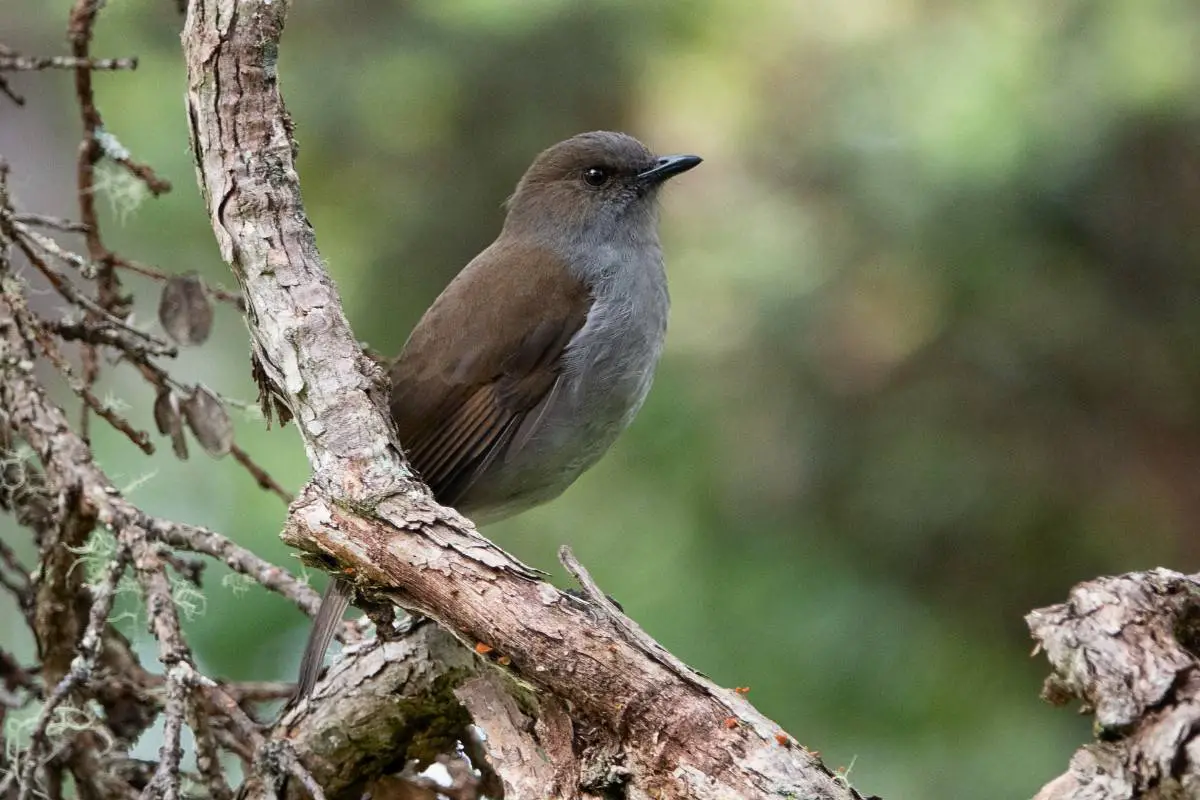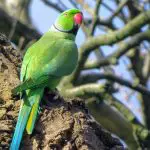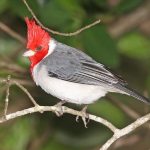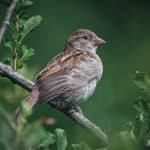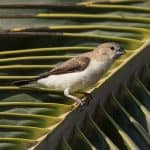Omao on tree branches | image by Bettina Arrigoni via Wikimedia Commons | CC BY 2.0
Common Name: ʻOmaʻo
Scientific Name: (Myadestes obscurus)| Size | Diet | Range in Hawaii | Status in Hawaii |
|---|---|---|---|
| 7 in. - 8 in. | fruits, seeds and insects | Big Island | Vulnerable |
The Omao, also known as Myadestes obscurus, is a small bird species that is native to Hawaii. Found throughout the native windward rainforests of the islands, the Omao is an important part of Hawaii’s unique biodiversity. With its distinctive song and beautiful plumage, the Omao is a beloved sight among bird enthusiasts and a symbol of the islands’ natural heritage.
In this article, we will explore the fascinating world of the Omao, its unique characteristics, and its presence in Hawaii.
Omao
Appearance
The Omao is a captivating bird with a unique appearance. It measures approximately 7-8 inches in length, showcasing a medium-sized body. The Omao flaunts a stunning combination of colors, featuring a rich brownish-black plumage that engulfs its entire body.
With its bright orange eyes and a prominent beak, this avian species stands out amidst the lush greenery of the Hawaiian rainforests. The Omao’s distinctive appearance adds to the allure of encountering this remarkable bird in its natural habitat.
Diet
This Hawaiian thrush is a versatile forager, indulging in a wide range of culinary delights. From juicy berries and delectable fruits to nutritious seeds and delectable insects, the Omao has a palate that truly reflects the abundance of its rainforest habitat. With its keen eye for spotting food sources, this bird effortlessly balances its diet, making it an important player in dispersing seeds and contributing to the ecosystem’s vitality.
Nesting
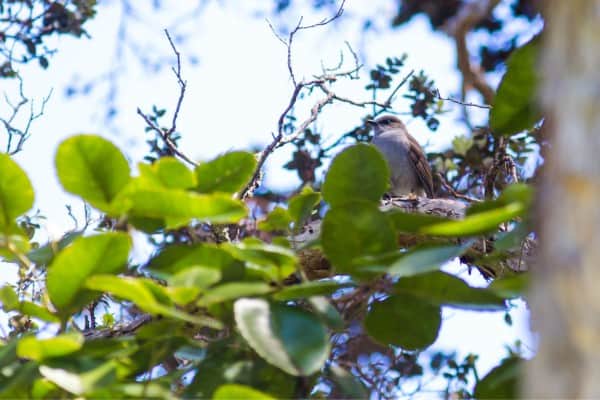
As the breeding season approaches, the male Omao embarks on an extraordinary quest to find the perfect nesting site. With its glossy black plumage and melodious song, the male Omao serenades potential mates, showcasing its vitality and prowess. Once a suitable partner is captivated, the pair embarks on the joint venture of constructing a nest.
High in the branches of a native tree, the Omao meticulously weaves together an intricate structure of twigs, leaves, moss, and fern fronds. This skillful craftsmanship results in a cozy, cup-shaped nest that offers security and protection for the forthcoming brood.
The Omao’s nesting habits are not limited to a single breeding season. Remarkably, they exhibit a remarkable behavior known as “nest stacking.” Instead of building a new nest each year, they opt to reuse and expand their existing nests. Over time, the Omao adds layers to the original structure, creating a towering stack of nests, resembling a natural skyscraper in the forest canopy.
This nesting strategy provides the Omao with several advantages. The stacked nests act as a defense mechanism against potential predators, as the sheer height and complexity of the structure make it difficult for intruders to reach the vulnerable eggs or nestlings. Additionally, the accumulation of nests over time creates a cozy microclimate within the stack, offering insulation during cooler nights and protection from inclement weather.
The Omao’s nest stacking behavior also fosters a sense of community within the species. As neighboring Omao families build their own nests nearby, the forest canopy becomes an intricate tapestry of interconnected nests, forming a bustling avian metropolis.
Behavior
One remarkable aspect of the Omao’s behavior is its feeding strategy. These omnivorous birds possess a strong affinity for fruit, particularly those borne by native Hawaiian plants. With their sharp beaks and keen eyesight, Omao deftly pluck and devour a diverse array of fruits, contributing to the dispersion of seeds and aiding in the regeneration of the island’s ecosystem.
Adding to their allure is the Omao’s enchanting song. These gifted vocalists possess a wide repertoire of melodic tunes that reverberate through the forest canopy.
Their sweet, flute-like calls intertwine with the natural symphony of the Hawaiian wilderness, filling the air with a mesmerizing chorus. The males often engage in spirited duets, competing to showcase their vocal prowess and attract potential mates, creating a captivating auditory experience for fortunate listeners.
The Omao’s behavior is not limited to individual pursuits. These birds exhibit a strong sense of community and engage in social interactions with their counterparts.
They form flocks, allowing them to forage together, share information about food sources, and warn each other of potential dangers. This cooperative behavior enhances their chances of survival and ensures the collective well-being of the group.
During the breeding season, the Omao’s behavior takes on a more intimate dimension. Males engage in elaborate courtship displays, showcasing their agility and plumage while serenading potential mates.
In the realm of flight, the Omao demonstrates remarkable agility and precision. They effortlessly navigate through the dense foliage, displaying swift and acrobatic maneuvers as they chase insects or evade predators. Their ability to soar through the canopy with grace and dexterity is a testament to their exceptional flying skills.
Habitat

The Omao’s habitat encompasses a diverse array of environments, ranging from montane rainforests to mist-shrouded cloud forests and even occasionally extending into lower elevations. These habitats are characterized by an abundance of native plants, including ohia lehua trees, hala pepe, and koa trees, which provide essential resources for the Omao’s survival.
Range
The O’mao found in the upper-elevation forests of the island of Hawaii. It primarily inhabits the eastern slopes of Mauna Loa and Mauna Kea, with the highest population densities recorded in the Ka’u district.
In recent years, a population has also been discovered on the southwest slopes of Mauna Loa. The O’mao is adapted to forested habitats and is commonly observed in high-elevation cloud forests, alpine scrub, and native forests on the island.
Conservation Status
The Omao is currently classified as “Vulnerable” on the IUCN Red List of Threatened Species. This designation signifies the significant risks this bird species faces in terms of survival and underscores the urgent need for conservation efforts to protect its population and habitat.
Interesting Facts
1. Taxonomic relatives
The Omao belongs to the thrush family (Turdidae), which includes other well-known birds such as the American Robin. Despite its taxonomic association, the Omao exhibits distinct characteristics and behaviors that set it apart from its mainland relatives.
2. Vulnerability to avian malaria
Like many other Hawaiian forest birds, the Omao is highly susceptible to avian malaria, a disease transmitted by introduced mosquitoes. The presence of the disease, coupled with the limited resistance of native Hawaiian birds, poses a significant threat to the Omao’s population.
3. Cultural significance
The Omao holds cultural significance in Hawaiian mythology and folklore. It is associated with various legends and is often regarded as a messenger between the human and spirit worlds, adding a touch of mystique to its presence in Hawaiian culture.
4. Symbol of Hawaiian biodiversity
The Omao serves as a symbol of the remarkable biodiversity found in the Hawaiian islands. Its presence reminds us of the importance of preserving and safeguarding these delicate ecosystems for the benefit of both native species and future generations.
5. Feeding behavior
The Omao employs a feeding technique known as “gleaning.” It actively searches for insects and other invertebrates by carefully inspecting the surfaces of leaves and branches, picking off prey items with precision and agility.
Frequently Asked Questions
1. Why is the Omao’s conservation status vulnerable?
The Omao faces threats such as habitat loss and degradation due to deforestation, invasive species, and avian diseases like avian malaria. These factors have led to population declines, resulting in its vulnerable conservation status.
2. Can the Omao be kept as a pet?
No, it is illegal to keep native Hawaiian birds like the Omao as pets. They are protected under state and federal laws to ensure their conservation and prevent illegal wildlife trade.
3. How long does the Omao live?
The lifespan of the Omao in the wild is not precisely known. However, similar bird species in the thrush family have been known to live for 5 to 10 years or more.
4. Can the Omao be found on all the Hawaiian Islands?
The Omao is found on several Hawaiian Islands, including Hawaii (Big Island), Maui, Kauai, and Oahu. However, its distribution may vary among islands, with different subspecies adapted to specific environments.
5. How do researchers study the Omao in the wild?
Researchers use various methods to study the Omao, including bird banding to track individuals, acoustic monitoring to record and analyze their vocalizations, and habitat surveys to assess population numbers and distribution.
